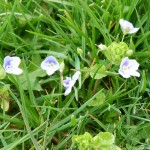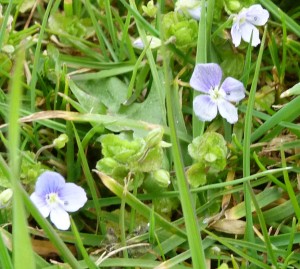Common Speedwell
Latin: Veronica persica
Irish: Seamar chré
This is a small, prostrate, widely distributed annual that often occurs as a weed in tilled fields but also occurs in grassland. It has tiny (10-12mm across) but very attractive flowers with 3 sky-blue petals and 1 white petal. Although individual flowers endure for only a short time, seeds germinate and flowers open during most of the year (March – September). It is not native and is believed to have been introduced from south-west Asia several centuries ago.
It is a small plant but it is such a strong competitor for soil nutrients etc. that it can significantly impair the growth and performance of cereal crops when there are more than 2 or 3 Veronica plants per square foot.
The name is derived from the story that St. Veronica wiped Jesus’s face with Speedwell flowers on his journey toCalvary. As a result of this, healing properties were transferred to the plant. Medical uses include clearing sinus congestion, easing eye soreness and helping eyesight.
In Ireland, speedwell was traditionally sewn into the garments of travellers to protect them from danger and the water from a boiled mixture of speedwell and other herbs was given to cows with calf to protect them against bad luck and the fairies.
 “Speedwell” was also the name of the ship that was to accompany the “Mayflower” when it set sail from England in 1620 carrying the Pilgrim Fathers to North America.
“Speedwell” was also the name of the ship that was to accompany the “Mayflower” when it set sail from England in 1620 carrying the Pilgrim Fathers to North America.
Veronica persica can be found at many locations at the edges of fairways and in the rough at Castlewarden. They are especially numerous and visible in the rough on the south side of the ESB pylon beside the 5th fairway.
